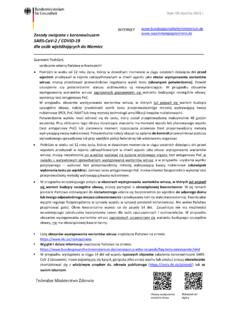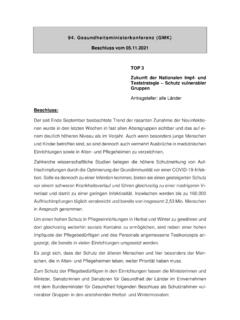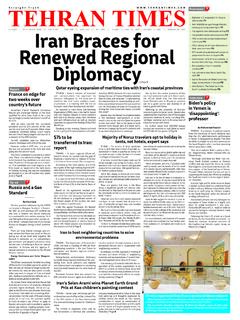Transcription of The German healthcare system
1 The German healthcare system Strong. Reliable. Proven. Foreword Dear Readers, Across the world, healthcare systems are at the heart of efforts to cope with the current COVID-19 pandemic. Because a political response to mitigate the economic and social consequences of the pandemic will not be possible unless the spread of the coronavirus is stopped. A crisis like this reveals whether the existing structures and processes can stand up to extraordinary pressures, and whether the actors involved have sufficient capacities and resources to provide the population with medical care and effectively fight infec- tions for which neither a vaccine nor a treatment are immediately available.
2 We must all use this crisis to strengthen our resources where deficits have been exposed. Because there is certain to be another pandemic or a similar medical emergency in the future! At the same time, the COVID-19 pandemic has made it very clear that the challenges we face are not just a national matter. The virus does not stop at borders. The European and global dimensions of the crisis have especially been highlighted by the supply of medicines and medical supplies and equipment. From 1 July to 31 December 2020 Germany holds the Presidency of the Council of the European Union and so will assume key responsibilities within the EU framework.
3 For the health portfolio, this primarily means considering questions relating to the ongoing pandemic in their European perspective and learning the lessons that have to be learnt to ensure that we in Europe are even better prepared in future. But there are also other urgent healthcare topics that are of great importance for the future of Europe and its ability to withstand crises. So during Germany's Presidency of the Council of the European Union, we want to drive forward digitalisation and the use of big data and artificial intelligence in the health system , and we want to safeguard and improve the supply of pharmaceutical products and medical devices in the EU.
4 Joint European solutions always work particularly well when they take national specifi- cities into account. These specificities often go back a long way and mean that in many areas the structures and processes in the member states differ from one another. Health systems in Europe have also adapted to the different national circumstances and condi- tions and so are different in themselves. This publication provides an overview of the German health system and explains its main institutions and regulatory mechanisms.
5 We hope that it contributes to an understanding of the different healthcare systems in Europe. Because it is only with understanding for one another especially in a medical emergency like the COVID-19 pandemic that we and our partners in the EU and worldwide can ensure the medical treatment of citizens, improve our systems and create genuine added value in the context of the EU. Jens Spahn, Federal minister of Health Contents A long history: the basic principles of the healthcare system 6. Multiple networks: the actors in the healthcare system 14.
6 Dependable protection: statutory health insurance (SHI) 22. All-round support: medical and nursing care 28. Structurally dynamic: challenges and opportunities 40. German healthcare facts and figures 48. The Federal Ministers of Health from 1961 to today 50. Glossary 51. Reference sources 54. Information from the Federal Ministry of Health 56. Imprint 61. A long history: the basic principles of the healthcare system Providing Germany's population of 83 mil- lion with medical care is a massive task. Delivering this healthcare draws on a net- work of around 1,900 hospitals1, 150,000.
7 Doctors2, 28,000 psychotherapists3 offering outpatient care and almost 19,500 pharma- cies4. The costs of this healthcare system are healthcare in high more than 391 billion5 was spent on healthcare in Germany in 2018 according to Germany is based on the latest figures from the Federal Statistical five principles Office. That is more than a billion euros a day. In other words, over one in ten euros Mandatory insurance of Germany's GDP goes on healthcare . Statutory health insurance (SHI) and private health insurance (PHI) were made manda- The healthcare system is financed by statu tory on 1 April 2007, and as of 1 January 2009.
8 Tory and private health insurance. Today's everyone registered or usually resident in system has a long history. The first precur- Germany is required to take out health in- sors of a mutual health insurance system surance. Employees are required to make can be found in the Middle Ages. Guilds SHI contributions if their income is below and some companies assumed responsi- a certain level (in 2020 the threshold was bility for financing medical and nursing 5, per month). If their monthly in- care for their members and employees.
9 Come exceeds this level, employees can The different forms of social safety net retain membership of the SHI on a voluntary that evolved over the centuries were har- basis or elect to take out private health in- monised in the course of the 19th century. surance. Some groups are also exempt One milestone was the world's first system from mandatory contributions to the SHI. of social insurance introduced in 1883 by regardless of their income level. They in- the German chancellor at the time, Otto clude civil servants and the self-employed, von Bismarck.
10 It laid the foundations for for example. the statutory health insurance system in Germany, which today covers most of the country's residents. A network including some 1,900 hospitals, 150,000 doctors and 28,000 psychotherapists offering outpatient care, as well as almost 19,500 pharmacies, provides healthcare services to roughly 83 million people in Germany 8. also charge an additional premium, which currently averages around one percent and of which the employer also pays half. People insured privately may also be sub- sidised by their employer or pension fund.
















